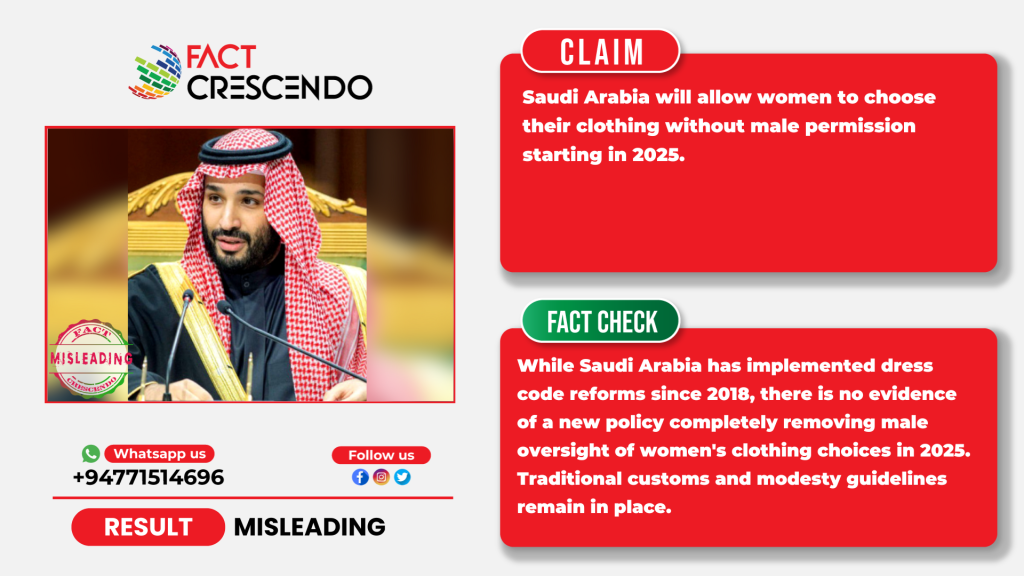
A recent claim has drawn attention regarding a significant policy shift in Saudi Arabia that would allow women to decide what they wear. Given the historical and cultural significance of dress codes in Saudi Arabia, this claim warrants a detailed fact-check to verify its accuracy and provide context on the evolving status of women’s rights in the kingdom.
Social Media Posts
Recently, multiple social media users have shared a claim that Crown Prince Mohammed bin Salman announced, “From now on, women in Saudi Arabia will be able to decide what they wear without male permission.” This claim has been circulating widely across various online platforms.
Fact Check
Background: Dress Code Reforms in Saudi Arabia
For many years, Saudi women had to follow strict clothing rules that required them to wear an abaya (a loose black robe) and usually cover their head or face. These rules were enforced by a special religious police force called the Saudi Commission of Virtue and Prevention of Vice CPVPV. But in 2016, Crown Prince Mohammed bin Salman (MBS) introduced reforms that limited the power of this religious police, making dress code enforcement less strict.
A bigger change came in 2018, when MBS announced during a CBS News interview that women no longer had to wear the abaya or headscarf, as long as they dressed “decent and respectful.” This change gave Saudi women more choices in how they could dress.
Current Dress Code Regulations
Since 2019, Saudi Arabia has implemented progressive changes to women’s dress codes. The traditional abaya and headscarf, while no longer legally required, remain widely practiced as cultural customs. The Public Decorum Charter now provides a framework for acceptable attire that balances modernization with cultural values.
Current dress code guidelines focus on modesty and respect, prohibiting:
- Offensive or inappropriate imagery on clothing
- Clothing that doesn’t cover knees and elbows
- Sleepwear or undergarments in public
- Swimwear in public areas
- Form-fitting or transparent clothing
- Non-Islamic religious symbols
The guidelines also specify acceptable practices. Footwear choices are generally unrestricted, though shoes must be removed in mosques. Make-up is widely accepted, with an emphasis on subtle, sophisticated looks. While black remains the traditional color choice, women increasingly opt for abayas in various colors and patterns, particularly among younger generations.
For children, dress codes are more flexible. Girls typically transition to traditional dress during their early teens, beginning with the abaya and later adding the hijab, though these practices vary by family.
Evidence of a 2025 Policy
Claims have circulated about a new announcement in 2025, but there is no verifiable evidence from official Saudi government sources, news outlets, or statements from Prince Mohammed bin Salman confirming such a policy change in 2025. The most recent reforms on record, as of early 2025, build on the 2018 statement and earlier changes, with no indication of a complete removal of male oversight. In fact, human rights group ALQST reported in 2024 that while reforms have progressed, many clothing designs remain prohibited, and male guardianship laws continue to limit women’s autonomy in various aspects of life, including personal choices like clothing. This suggests that the claim of a new 2025 policy granting full autonomy over clothing choices without male permission is not supported by available evidence.
Male Guardianship and Personal Choice
Saudi Arabia’s male guardianship system remains relevant to discussions about women’s clothing choices. While reforms have expanded women’s rights in areas such as travel and employment, cultural and familial practices continue to influence dress decisions. When Crown Prince Mohammed bin Salman announced modifications to dress codes, the policy did not explicitly state requirements regarding male approval for women’s clothing selections.
Conclusion
Claims that Saudi Arabia will allow women to choose their clothing without male permission in 2025 are inaccurate. While dress code reforms have progressed since 2018, no evidence supports a complete removal of male oversight, and traditional customs still influence women’s clothing choices.
Source: The Restless Beans, VOA, Reuters

Title:Misleading: No Sign of Changes to Saudi Women’s Clothing Permissions in 2025
Fact Check By: Cielito WangResult: Misleading






